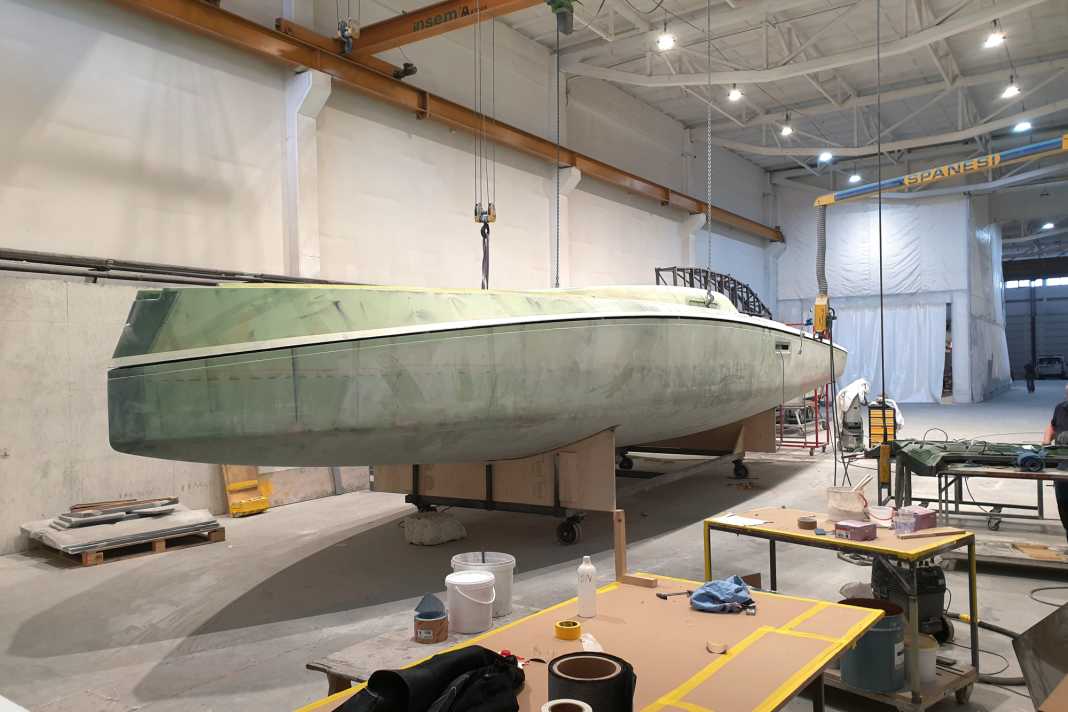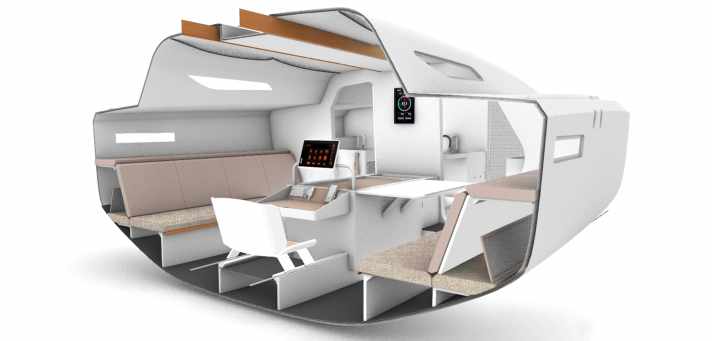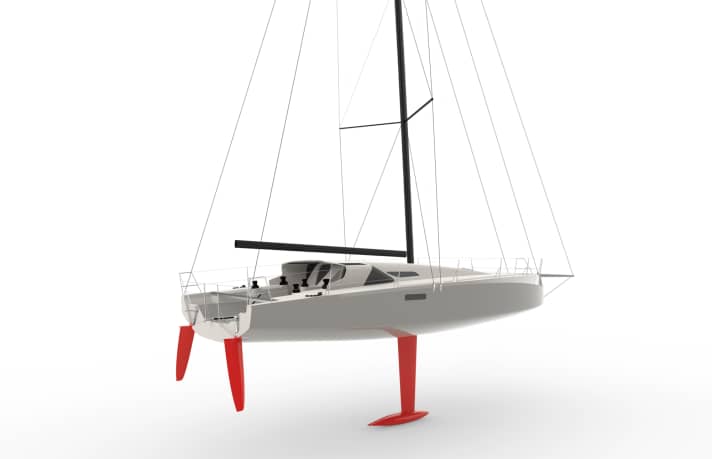





When you see the plans and computer animations of the JV 43, you can't help but think of an ocean racer. And that's not entirely wrong. After all, what has taken shape on Antoine Cardin's computer in Bremerhaven shows an almost twin-like relationship to a modern Class 40: the hull is flat-bottomed, the bow extremely full-bodied, the T-keel slim and deep, the rig with plenty of drop aft, the cockpit protected in the forward section by the extended coachroof, the twin rudders retractable.
In reality, however, the design is merely a derivative of the most successful offshore class of the last 20 years. The boat, which was built in a small series, is a hybrid that is also intended to be suitable for longer offshore trips. From the outside, there is little to suggest this, at most the superstructure extended towards the foredeck and the two narrow hull and cabin windows on either side, which no longer exist in the latest generation of the Class 40.
The biggest challenge is hidden below deck
The biggest difference - and also "the biggest challenge during development", as designer Antoine Cardin from Judel/Vrolijk & Co says - lies hidden below deck. The JV 43 is the fastest performance cruiser of its size imaginable - with the exception of performance-orientated multihulls such as the JV 43. Dragonfly 40 or Rapido 40.
In the saloon, of which one can certainly speak here, there is a large seating area arranged around the extremely forward engine box. Aft of this is the central navigation area, with the wet room to port in front of the main bulkhead and the galley to starboard. The owner's cabin in the foredeck, which extends over almost a third of the entire length of the boat, is also huge thanks to the scow-bow design and offers a generously sized double berth with plenty of storage space and room to move around.

Maintaining the level of the Class 40
Even more astonishing than the large volume and the sheer, yet seaworthy and impressive design of the superstructure is its weight. "The target was 250 kilograms," says Antoine Cardin. "That's the only way we can stay roughly at Class 40 level in terms of performance."
He pays strict attention to adherence to the limit, even if it is of course ultimately up to the owners to decide how much moderation they apply. Anything that improves comfort on board but reduces the potential of the design needs to be carefully weighed up.
For example, dispensing with the hull windows and an inverter - nowadays a matter of course for cruising yachts in this size and price category - can compensate for the additional weight of a gimbal-mounted cooker with oven. The omission of doors, even if they are made of foam sandwich, can make way for a hot water boiler or a heating system. And so on. Only one thing is not possible: everything.
The key to a foreseeably breathtaking sailing experience
It is the almost irritating radicality of the approach compared to large-scale production that makes the boat so unique. What sounds like relentless asceticism in a yacht that will cost between 800,000 and 900,000 euros ready to sail is actually the key to a foreseeably breathtaking sailing experience. The technical data alone shows this.
They make the JV 43 a solitaire on the market. At just under 5.2 tonnes, it displaces just half as much as the new First 44 - and still has a good 20 percent more sail area on the wind. Her sail carrying capacity of 6.45 tonnes is only exceeded by the ClubSwan 36 which is also being built in series, but is designed purely as a regatta yacht and has no extension. With a value of 6.5, modern Class 40s such as the Pogo S4 are only slightly higher than the Judel/Vrolijk design.
For the Bremerhaven design office, otherwise better known for series-produced ships and Grand Prix racing yachts such as the TP52, the order was very welcome. By working on this ambitious project, the engineers can show how broad their portfolio is, how individually they are able to respond to unusual owner requests and that they also feel at home in the domain of shorthanded offshore sailing, which is actually a French domain.
JV 43- a hybrid sailing yacht
On the one hand, the design is reminiscent of the early Class 40 boats such as the first Pogo 40 or the Akilaria RC1, which were also divided into sections at the time and not completely open like today's designs, whose raw "interior" consists solely of stringers and ring frames.
On the other hand, Antoine Cardin has incorporated all modern findings into the hull design - including the scow-like bow section and the slightly concave moulded underwater hull in the aft area, which is intended to reduce water resistance when gliding at speed. The design also has a relatively large keel step and a small wetted surface, all of which are state-of-the-art features in the Class 40.
The initiative came from two Hamburg owners, both experienced ocean sailors, who had been in dialogue with Judel/Vrolijk for some time about a fast, ocean-going vessel. Together with Antoine Cardin, they agreed on three basic premises that perfectly summarise the design: "Speed, Simplicity, Space". Initially, they only commissioned a study, then the complete design.
Goal: best possible all-round performance
The hull shape was developed on the basis of 15 comparison models, all analysed with the latest CFD program. The aim was to achieve the best possible all-round performance. This applies not least to the upwind properties, which are otherwise not the paragon of modern offshore designs. "Unlike the latest generation of the Class 40, the JV 43 still has slight rudder pressure on the cross," says Cardin. And this is despite the fact that the mast only leans 5 degrees aft instead of the usual 8 to 10 degrees in this class. Although no super-tight turning angles are to be expected, the boat sails most efficiently in a "low-and-fast mode" - 5 to 6 degrees lower than other performance yachts, but 1 to 1.5 knots faster.
The deck layout is optimised for a small crew and short distances and offers several seating positions as well as protection from spray under the aft-facing coachroof. There are five winches on the central trim console. All lines and halyards run back into the cockpit area so that manoeuvres can be carried out efficiently and safely.
The carbon rig from Axxon measures 80 centimetres more than a Class 40 mast. The forestay is made of carbon, the shrouds of rod and the backstays of Dyneema. The sail plan is similar to that of an Imoca with foresails, space wind and reaching sails, most of which can be furled. The non-overlapping jib measures 55 square metres. For strong winds there is a removable staysail, for more open courses a jib top, a code zero as well as a top and a fractional gennaker. An inventory that ranges from 5 to over 40 knots and is very versatile.
Sailing yacht is manufactured by Oceantec in Slovenia
The boat is being built at Oceantec, a highly capable shipyard in Jesenice, Slovenia, which specialises in ambitious projects of this kind. The hull, deck and structure of build number one have already been finalised and the interior is well advanced. The yacht is due to take to the water for the first time in the northern Adriatic in June; the sailing tests, which we will accompany, will start immediately afterwards.
Meanwhile, construction number two is already maturing, albeit a few months behind schedule. And that's not the end of it. The design and moulds are also available to other owners for whom a Pogo 44 is too heavy but a Class 40 is too sharp. This reduces the costs, but above all the lead time. After all, the basic concept is already in place.
Technical data
- CE design category: A
- Torso length:13,10 m
- Total length: 15,06 m
- Waterline length: 11,52 m
- Width: 4,50 m
- Depth: 3,00 m
- Mast height above WL: 19,80 m
- Weight:5,16 t
- Ballast/proportion: 2,1 t/43 %
- Sail area on the wind: 124,0 m²
- Sail carrying capacity: 6,45
- machine (Yanmar 3YM30): 29 PS
- Interested parties for a licence construction contact the Design office Judel/Vrolijk & Co by mail: info@judel-vrolijk.com


